We may earn money or products from the companies mentioned in this post.
Embrace the energy and charm of Ho Chi Minh City, a city full of life, culture, and history. Welcome to a journey that invites you to explore the heart and soul of this vibrant Vietnamese city at your own pace. You can easily do your own walking tour of Ho Chi Minh, especially if you’re limited on time as a first time visitor.
This self-guided tour promises to unveil the rich offerings of Ho Chi Minh City, guiding you through iconic landmarks and hidden cultural gems of this captivating destination. So buckle up for an experience that combines the old and the new, offering a glimpse into the unique tapestry of Ho Chi Minh City’s past and present. You don’t need a tour guide or local guide unless you want to wander away from District 1.
Let’s embark on a discovery that crosses time and tradition, promising an unforgettable exploration of one of Southeast Asia’s most dynamic cities! This walking tour is perfect if you’ve only got a day to explore Ho Chi Minh as it showcases the top sights.
My advice is to take a taxi to your starting point and then walk from there. It is the most efficient way to explore the city during your walking tour of Ho Chi Minh. Use Google maps to help you navigate if you don’t want to download the attached map.
PRO TIP: If you want to visit the War Remnants Museum, make it your first stop and work your way through this list. But keep in mind that the Reunification Palace closes for lunch, so time yourself!
Is it Saigon or Ho Chi Minh?
In 1976, when North and South Vietnam reunified, the former city of Saigon, was renamed Ho Chi Minh. When people use the term Saigon today, they’re mostly referring to the central area, District 1, of the greater Ho Chi Minh City. People use the two names interchangeably, though the correct name is technically Ho Chi Minh.
Walking Tour of Ho Chi Minh
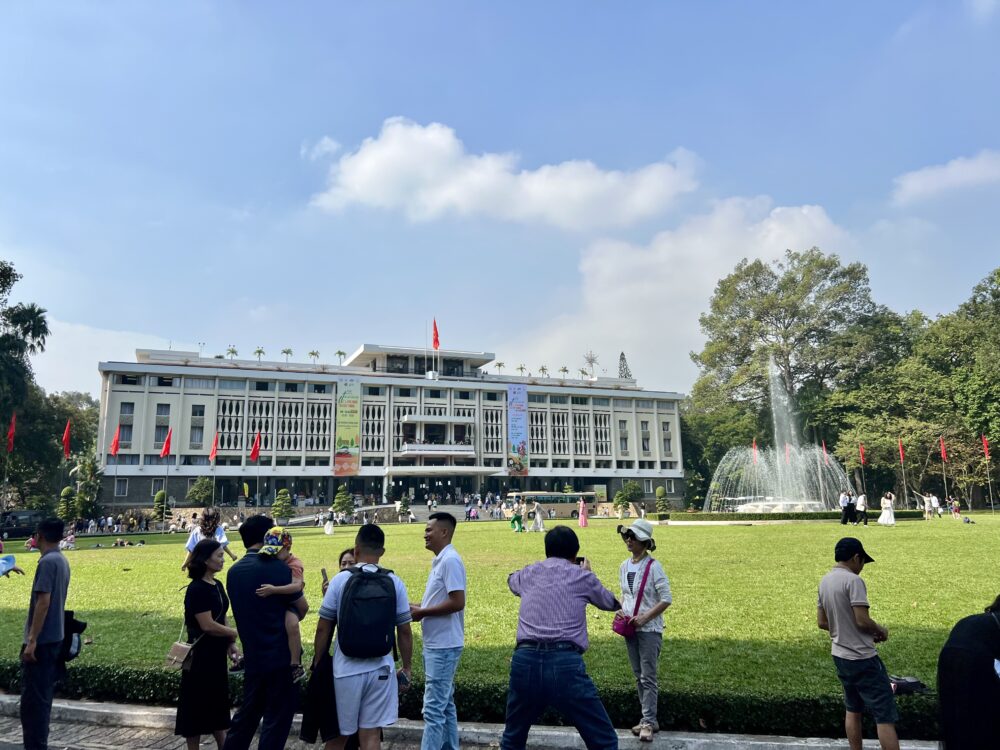
Reunification Palace
Begin your tour of Ho Chi Minh City with the famous Reunification Palace, a symbol of the city’s tragic history. As you enter this architectural masterpiece, you are transported to an essential historical period: the end of the Vietnam War.
Explore the historical chambers that bear witness to the nation’s political and cultural transformations. The lavish interiors of the Reception Hall, the strategic War Command Room, and the President’s Office offer an intriguing glimpse into Vietnam’s history.
Venture outside into the palace’s lush gardens, a serene oasis amidst the urban hustle. Here, you can explore pathways, admire fountains, and take in the carefully preserved tanks and helicopters, remnants of the past. For a more immersive experience, consider using an audio guide or joining a guided tour, as they provide deeper insights into the historical significance of each room.
The gardens are particularly enchanting in the late afternoon when bathed in the golden hues of the setting sun. This time of day offers a magical atmosphere, perfect for capturing photos and enjoying a moment of peace away from the crowds. As you go around the grounds, you can’t help but see its undeniable history – the location where a North Vietnamese tank slammed through the gates in 1975, signaling the fall of Saigon.
Make your way to the rooftop for panoramic views of Ho Chi Minh City. This viewpoint showcases the combination of modern skyscrapers and colonial-era architecture.
PRO TIP: The Reunification Palace closes for lunch from 11am to 1pm, so you’ll want to visit it first.
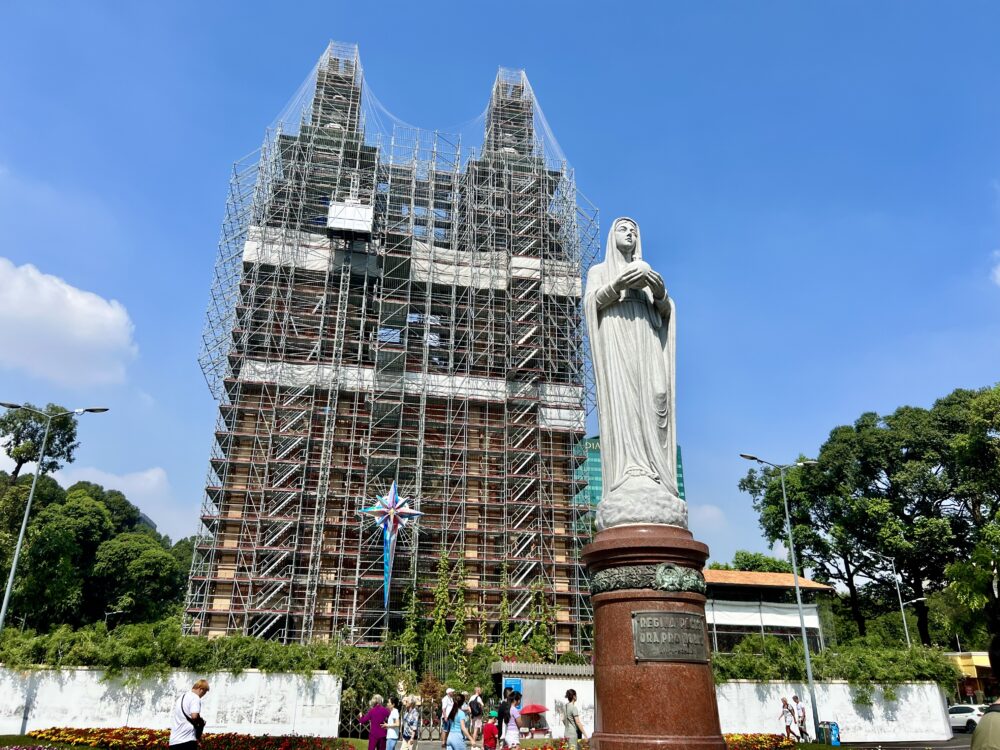
Notre-Dame Cathedral Basilica of Saigon
Your exploration of Ho Chi Minh City reaches a spiritual point as you arrive at the Notre Dame Cathedral, a breathtaking testament to French Gothic architecture and a tranquil oasis amid the urban hustle. Step inside to experience the tranquil ambiance that surrounds the Notre Dame Cathedral.
You’ll discover a feeling of serenity as sunlight flows through the stained glass windows,
spreading a variety of colors throughout the room. The echoes of whispered prayers and guests’ gentle whispers create an atmosphere that invites contemplation. Take a moment to admire the sacred relics, statues, and beautiful altar that grace the heart of the cathedral.
As you wander through the Notre Dame Cathedral, consider the historical significance of this Catholic landmark. Built in the late 19th century, it has witnessed the passage of time, including moments of celebration and reflection for both locals and visitors. The cathedral remains an enduring symbol of faith and cultural heritage in the heart of Ho Chi Minh City.
PRO TIP: The Notre Dame Cathedral of Saigon is undergoing renovations and will be closed to visitors until 2025.
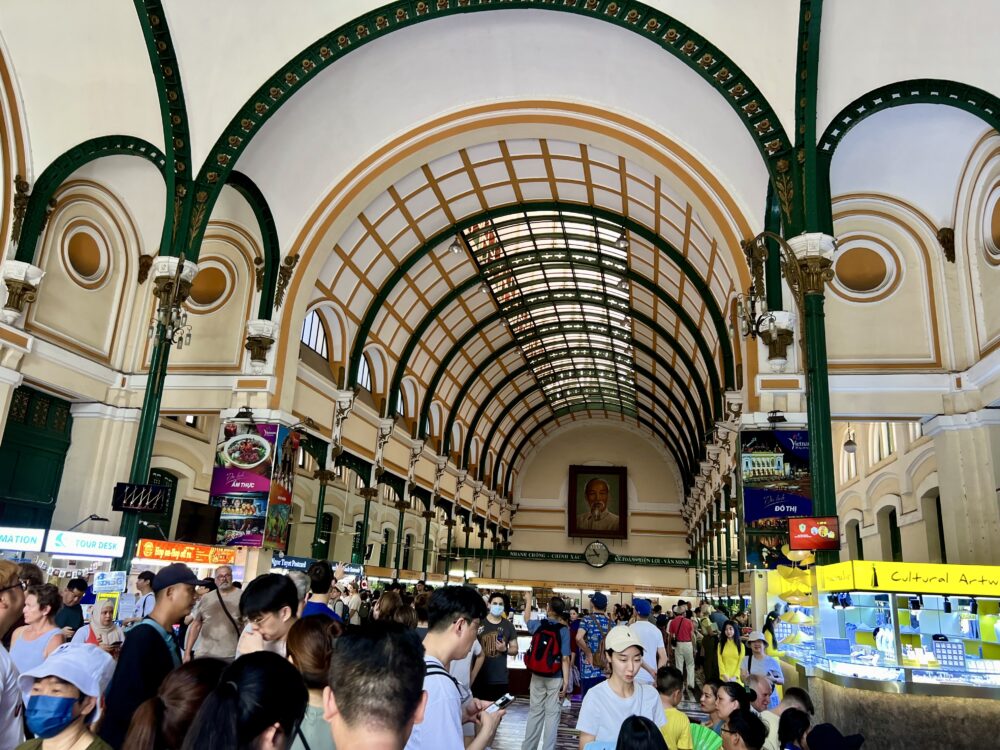
Central Post Office
Continuing your walking tour of Ho Chi Minh City, make your way to the Central Post Office, a real architectural gem constructed by Gustave Eiffel. Yes, it was built by the same man who did the Eiffel Tower. This iconic building is a testament to the city’s history, perfectly blending French colonial charm with functional elegance.
As you approach the Central Post Office, marvel at its unique façade, characterized by arched windows, a green dome, and intricate wrought-iron filigree. The exterior alone is a feast for the eyes, reflecting an era when communication was an art form.
Step through the entrance, and you’ll be transported to the past. The interior of the Saigon Central Post Office is a harmonious blend of neoclassical design and practicality. High ceilings, arched doorways, and a polished tile floor create an ambiance that exudes timeless elegance.
Take a moment to observe the enormous map of Vietnam that adorns the walls. It’s not just a decorative piece; it’s a historical artifact that adds a unique touch to the Post Office’s character.
As you look around the interior, you’ll notice a row of ancient telephone booths and desks where diligent postal workers perform their tasks. Then, proceed to the center of the hall, where a magnificent clock watches over the bustle of everyday life. It is next to a designated area for sending postcards and letters. Take advantage of this opportunity to share your Ho Chi Minh City experience with family and friends back home.
Purchase a postcard from one of the vendors within the post office, or bring your own. Sit at one of the wooden writing desks, let the pen glide across the paper, and capture the essence of your journey. Address the postcard, apply a stamp, and hand it to a reliable postal service that has been serving this location for over a century.
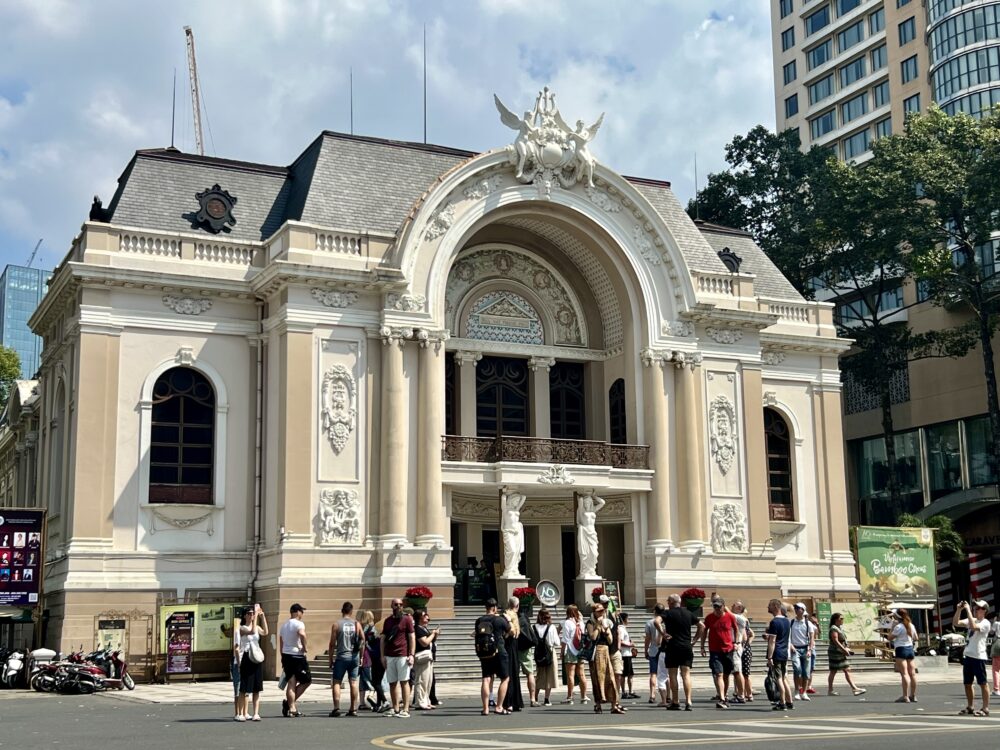
Opera Building
Your journey through the enchanting streets of Ho Chi Minh City leads you to another jewel of French architecture — the Opera Building. As you continue your exploration, this splendid structure unfolds before you, offering a glimpse into the city’s cultural richness.
Continue your walk, allowing the charm of the Opera Building to draw you closer. This grand structure is a testament to the city’s enduring appreciation for the arts, with its neoclassical design and exquisite detailing. The Opera Building, officially known as the Municipal Theatre of Ho Chi Minh City, is a cultural hub that exudes sophistication.
If time permits, inquire about upcoming performances or events at the Saigon Opera House. Attending a live performance, whether opera, ballet, or a traditional Vietnamese show, offers a unique and immersive cultural experience.
As you approach the Opera Building, take a moment to absorb the ambiance of the surrounding square. This area, often packed with locals and tourists, offers an ideal blend of cultural appreciation and urban activity.
If you get the chance, go inside the Opera House. With its delicate furniture and luxurious design, the interior takes you to a golden era of elegance and refinement. Even if you don’t attend a show, a quick stroll through the lobby is an immersive experience for art and architecture enthusiasts.
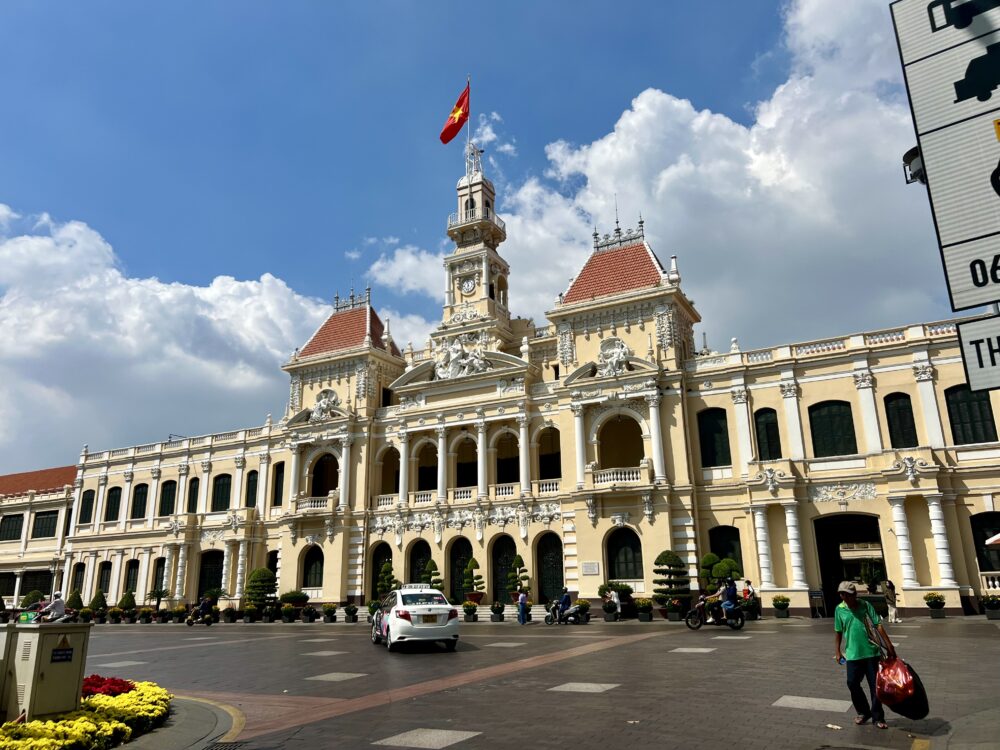
Ho Chi Minh City Hall
The Town Hall is the next stop on your self-guided walking tour of Ho Chi Minh City. This architectural marvel is a testament to the city’s colonial heritage, showcasing French beauty in the heart of Vietnam.
Stroll towards the Town Hall and let the grandeur of the building unfold before you. The Town Hall, also known as the Ho Chi Minh City People’s Committee Building, is a robust structure that captures attention with its neoclassical design and ornate detailing. Take a moment to appreciate the symmetrical beauty of this French colonial-era masterpiece.
Once you arrive at the Town Hall, you’ll find yourself in a bustling square surrounded by vibrant energy. The square hosts various events and gatherings, adding a dynamic touch to the historic setting. The combination of the Town Hall’s architectural splendor and the lively atmosphere of the square creates a unique and captivating scene.
Feel free to explore the surrounding area, as charming cafes and shops are nearby, especially along Nguyen Hue Street. Take a leisurely walk around the square, appreciating the contrast of the Town Hall against the modern backdrop of Ho Chi Minh City.
As you stand in front of the Town Hall, capture its architectural beauty through your lens, and you’ll find that each photograph tells a story of a city that embraces its history while embracing the pulse of modern life. A few hundred feet from the Town Hall, you’ll find the statue of Ho Chi Minh, worthy of a photo op.
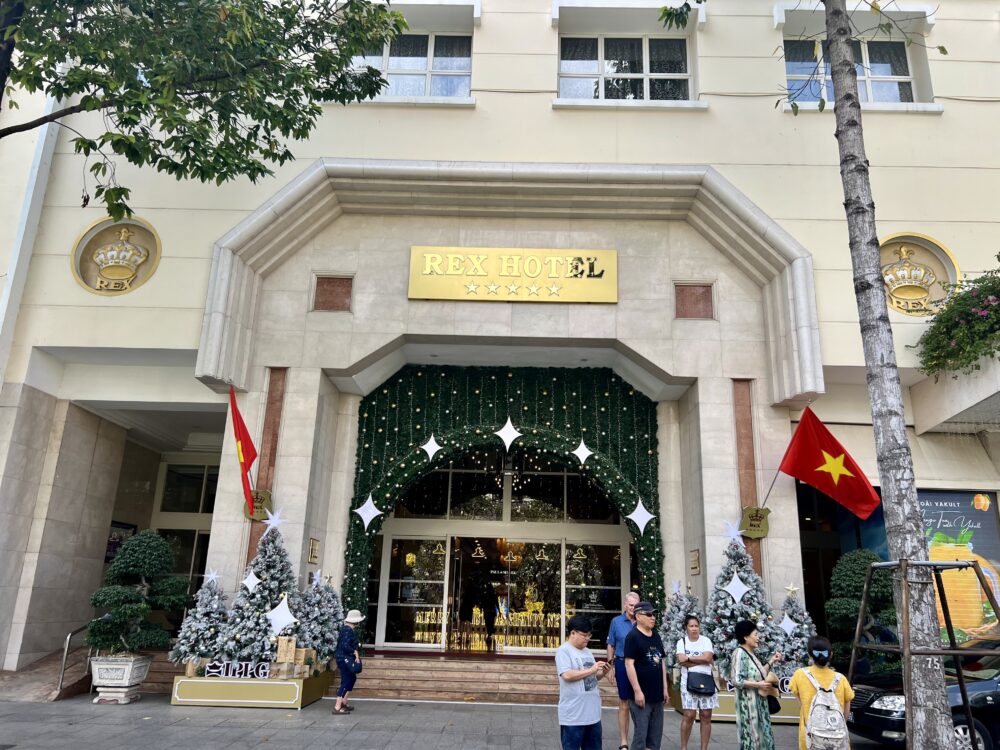
Rex Hotel
Your journey through Ho Chi Minh City continues as you make your way to the Rex Hotel, a historic landmark that represents the city’s enduring charm. The Rex Hotel, located in the heart of District 1, has played an essential part in the city’s history, making it a must-visit destination.
As you step into the Rex Hotel, you’ll be greeted by French colonial elegance and Vietnamese hospitality. Take a moment to appreciate the timeless architecture and the rich stories that echo within its walls. The Rex Hotel has witnessed the city’s transformation over the years, and its corridors provide an air of nostalgia.
However, the true highlight of the Rex Hotel awaits you on its rooftop. Climb to the top floor and discover the charm of the rooftop bar, which offers a panoramic view of Ho Chi Minh City’s skyline. You’ll find an opportunity to appreciate a delicious drink here amidst the pleasant air and open sky. Order your favorite beverage and choose a seat that offers unobstructed views.

Ben Thanh Market
Continue your adventure through Ho Chi Minh City by immersing yourself in the lively atmosphere of Ben Thanh Market, a bustling hub that highlights the city’s vibrancy. As you approach the market, the variety of colors, tempting aromas, and bustle of activity create a sensory feast.
Enter Ben Thanh Market, where the energy is evident, and the stalls are filled with local goods, handicrafts, and delectable street food. The market has been a commercial hub for decades, serving locals and visitors alike. This is the best spot to find souvenir shops.
You’ll come across stalls displaying various items as you go down the narrow aisles. Ben Thanh Market allows you to immerse yourself in the rich variety of Vietnamese handicrafts, from carefully embroidered fabrics and lacquerware to traditional Vietnamese hats and souvenirs.
Stop for a conversation with local artists, many of whom delight in crafting handcrafted products passed down through generations. The market offers an authentic look at the talents and traditions that define Vietnamese culture.
Amid the various stalls, the food section offers an irresistible array of local delicacies. Savor the aroma of freshly grilled meats, steaming bowls of pho, and the sweet fragrance of tropical fruits. Choose a spot to sit and relish a bowl of pho or a banh mi sandwich, watching the vibrant market life go by. Don’t be afraid to taste local favorites like fresh spring rolls, delicious Vietnamese pancakes, or strong Vietnamese coffee with condensed milk.
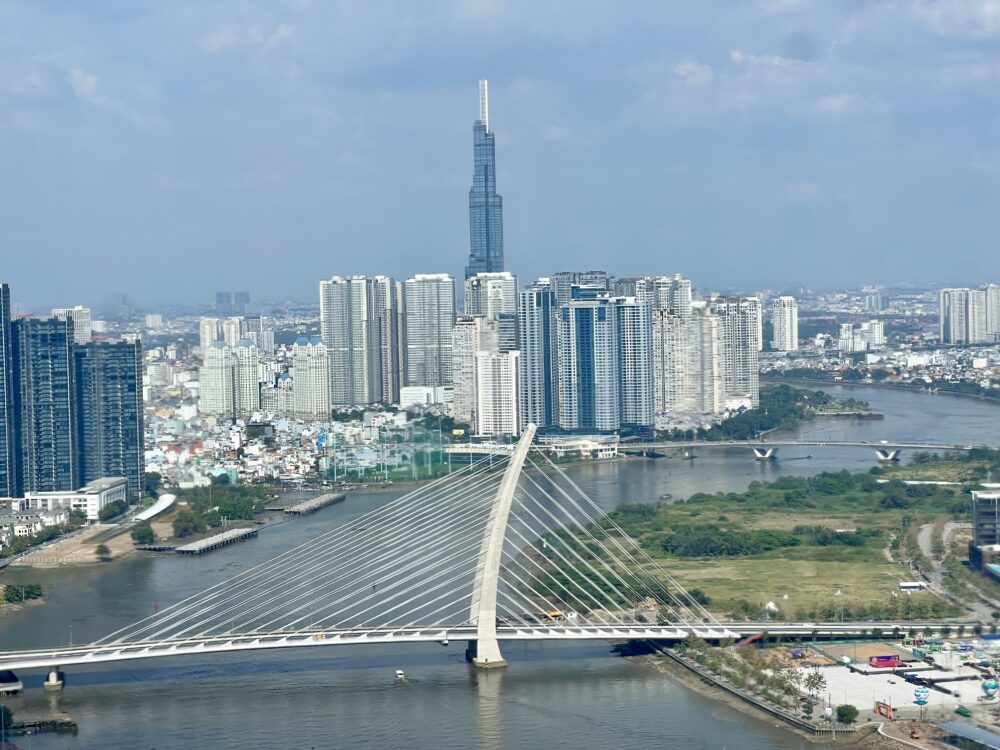
Bitexco Tower
Your journey through Ho Chi Minh City takes a modern turn as you reach the Bitexco Financial Tower, a soaring skyscraper that defines the city’s contemporary skyline. This architectural marvel invites you to witness panoramic views of Ho Chi Minh City from its famed Saigon Sky Deck.
Head towards the Bitexco Financial Tower and let its sleek and futuristic design capture your attention. As you approach, the tower’s distinctive helipad, resembling a lotus bud, becomes an eye-catcher against the backdrop of the bustling city.
Upon entering the tower, make your way to the Saigon Sky Deck, where an elevator ride will elevate you to new heights. Climb the tower’s impressive height and step out onto the Sky Deck, where floor-to-ceiling windows reveal a breathtaking 360-degree view of Ho Chi Minh City.
Take your time admiring the cityscape’s features, identifying landmarks like Notre Dame
Cathedral, the Reunification Palace, and the sprawling greenery that punctuate the urban expanse. The Saigon Sky Deck offers an escape from the bustling city below.
PRO TIP: The surrounding area is home to lots of coffee shops. Use this as an opportunity to try Vietnamese coffee!
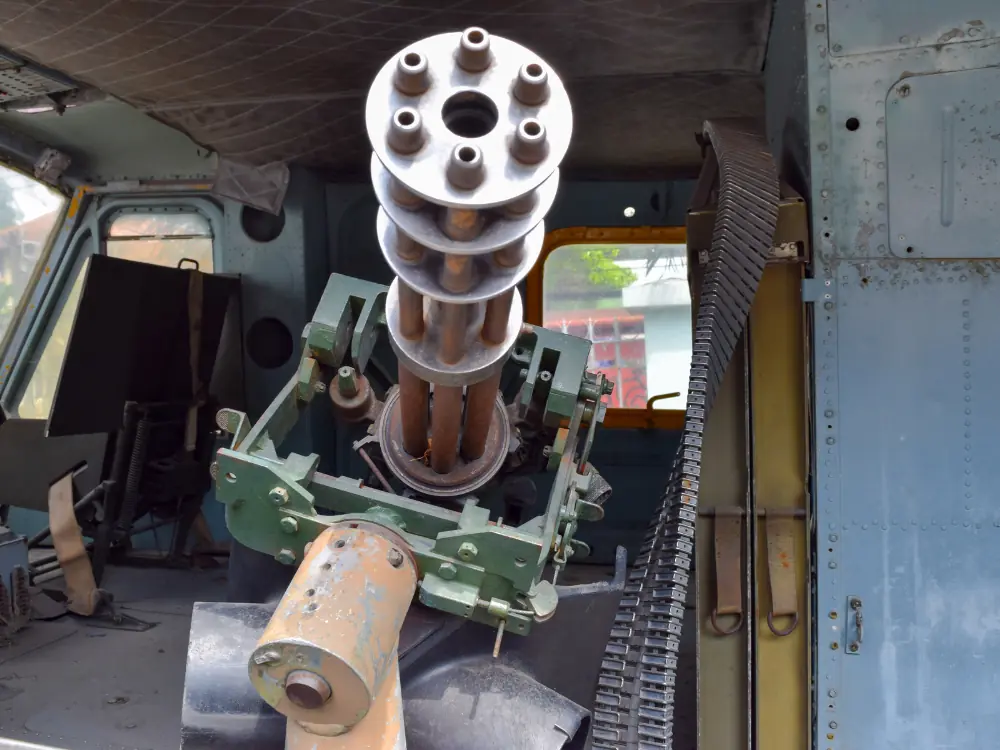
War Remnants Museum
Your journey through Ho Chi Minh City takes a contemplative turn as you delve into the significant chapters of Vietnam’s war-torn past at the War Remnants Museum. Located in the heart of the city, this museum serves as a dark yet essential testament to the country’s struggles and, more importantly, its resilience.
You’ll notice the exterior is adorned with military vehicles and aircraft, setting the tone for the impactful exhibits. The War Remnants Museum is a storehouse of memories, preserving the stories of individuals who lived through dark times.
Step inside to witness a series of exhibitions that explain the tragic experiences of the Vietnam War. Photographs, relics, and interactive exhibits document the wartime experiences of soldiers, civilians, and families, providing a deep insight into the Vietnamese people’s lives.
As you go around the museum, you will come across powerful images that represent the human toll of war, expressing both pain and resilience. The War Remnants Museum won’t shy away from the harsh realities of battle, providing a balanced representation of the war’s impact on both sides.
Take a minute to absorb the stories of bravery and the relentless spirit of the Vietnamese who endured immense hardships. The museum also sheds light on the post-war period, highlighting the country’s journey toward healing and reconstruction.
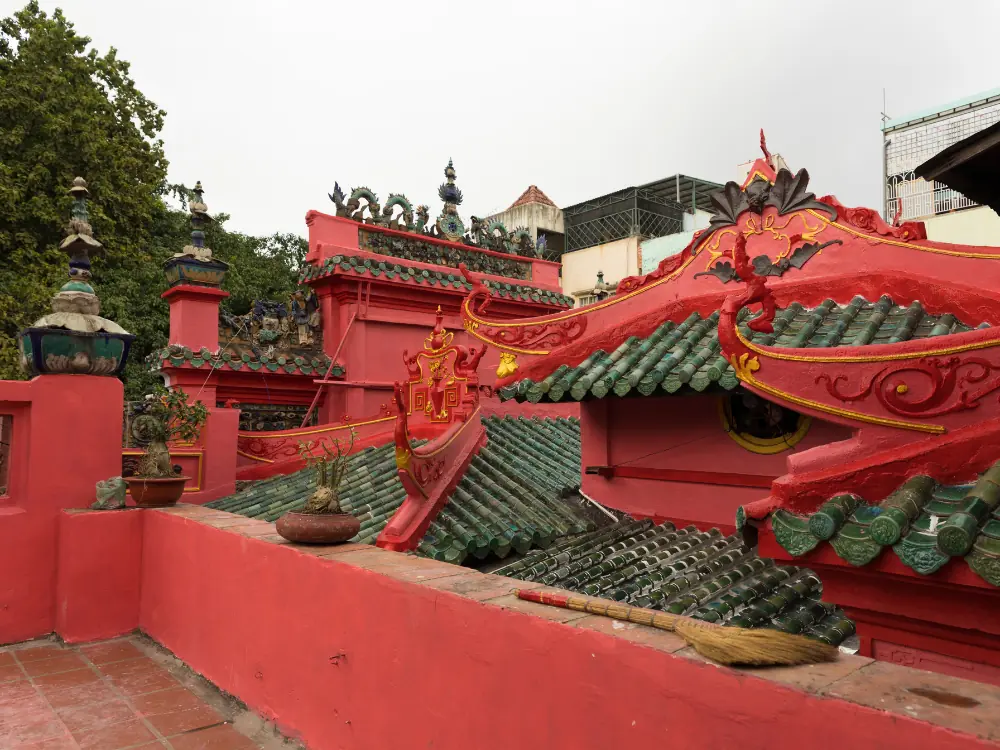
Jade Emperor Pagoda (District 3)
As your self-guided tour of Ho Chi Minh City ends and time permits, head to District 3 to witness the Jade Emperor Pagoda, a Taoist temple that embodies spiritual serenity and intricate architecture. This final stop on your tour provides a peaceful retreat in the middle of the city’s bustle. (You may want to take a taxi here.)
As you approach the Jade Emperor Pagoda, the subtle fragrance of incense calls you. This sacred Taoist temple, Phuoc Hai Tu, was built in the early twentieth century to honor the Jade Emperor, the most significant Taoist deity.
Step through the entrance adorned with elaborate carvings and enter a world of exquisite artistry. The Jade Emperor Pagoda captivates visitors with its intricate woodwork, mosaic tiles, and detailed sculpture, producing a visually magnificent representation of Taoist beliefs.
Explore the various halls and chambers within the pagoda, each dedicated to different deities and mythological figures. Admire the vibrant colors, intricate carvings, and delicate detailing that adorn the altars and walls, portraying scenes from Taoist cosmology and legends.
The highlight of the pagoda is the statue of the Jade Emperor himself, presiding over the main hall. Observe the devoted as they worship and make offerings, adding to the spiritual ambiance that surrounds the temple.
View the pagoda’s courtyard and garden, where bonsai trees and traditional architecture create a serene environment for reflection. The air is often filled with the soothing sounds of chimes and the gentle rustling of leaves, providing a break from the bustling city outside.
Before leaving, light an incense stick and give your silent prayers or reflections. The Jade Emperor Pagoda is not just a place of worship; it’s a cultural and spiritual journey that captures the essence of Taoist beliefs and practices.
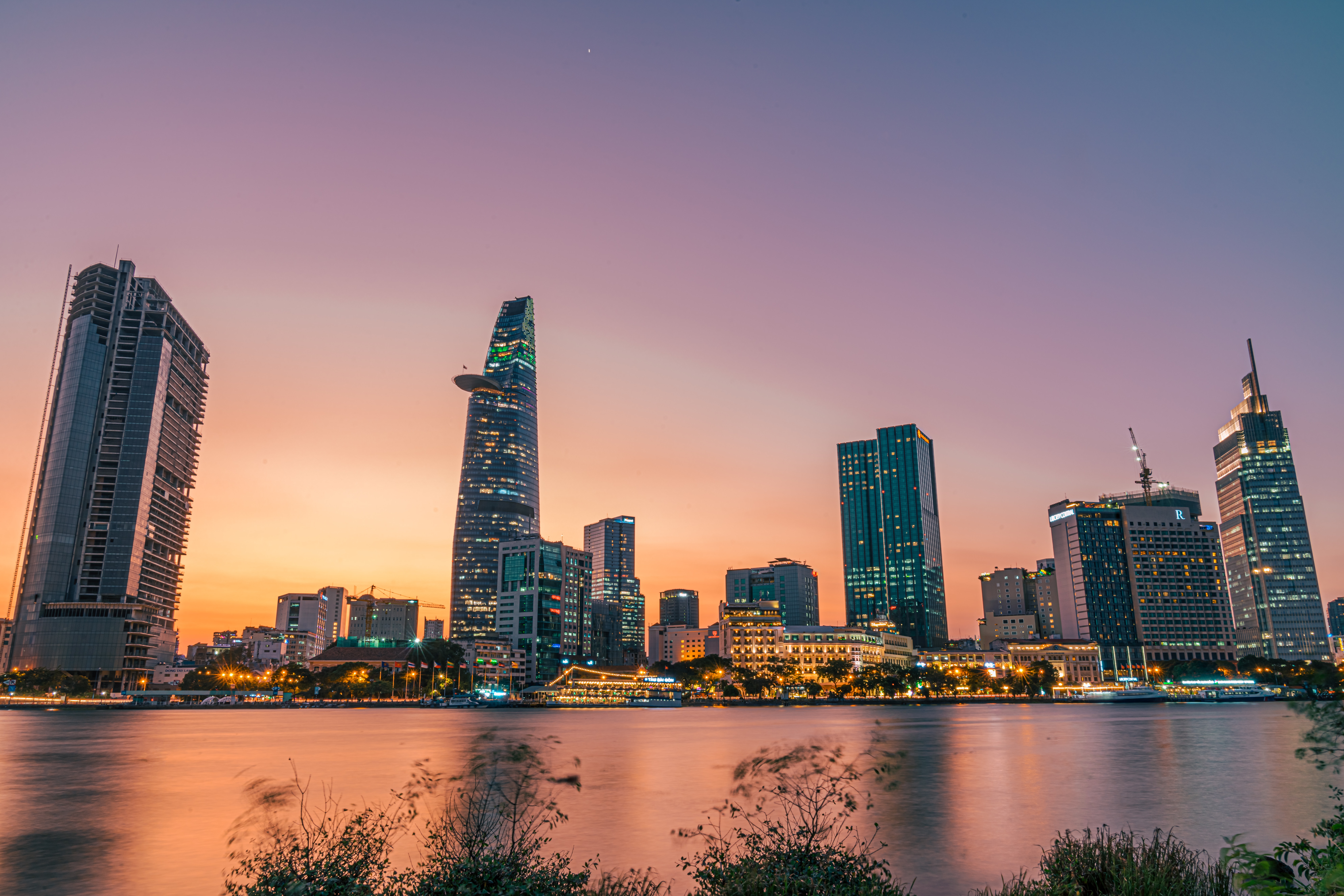
Know Before You Go to Ho Chi Minh
The language in Vietnam is Vietnamese. While some locals know some basic words in English and other languages, bring Google Translate with you!
The official currency is the Vietnamese Dong. While a few vendors may accept US dollars, don’t count on it and even fewer accept credit cards. Get some cash from an ATM that is connected to a bank.
Ho Chi Minh is known for bustling streets filled with mopeds. Use crosswalks when crossing streets but beware that vehicles have the right of way. Take a lot of care when crossing the street during this walking tour of Ho Chi Minh!
Taxis are metered and newer companies accept credit cards. The recommended companies (i.e., more reputable) are Mai Linh and Vinasun. The turquoise-colored VinFast taxis are electric and accept credit cards. You’ll want to have some cash as most taxis do not accept credit cards.
PRO TIP: Take a photo of the taxi cab number as you enter. If you should have a problem, you can contact authorities for assistance. If you accidentally leave your phone in a cab, you can recover it more quickly, too!
Final Thoughts on A Self-Guided Walking Tour of Ho Chi Minh
Don’t be intimidated by the thought of exploring this capital city on your own self-guided walk! It is easy to use this self-guided free walking tour of Ho Chi Minh to see the highlights of the Vietnamese capital city. Just bring a little cash and a sense of adventure!
Check out these related posts:
- Interesting and Free Places to Visit in Singapore
- Bucket List Experiences in Hong Kong
- A Day Trip to Macau
Happy travels,
Annick, The Common Traveler
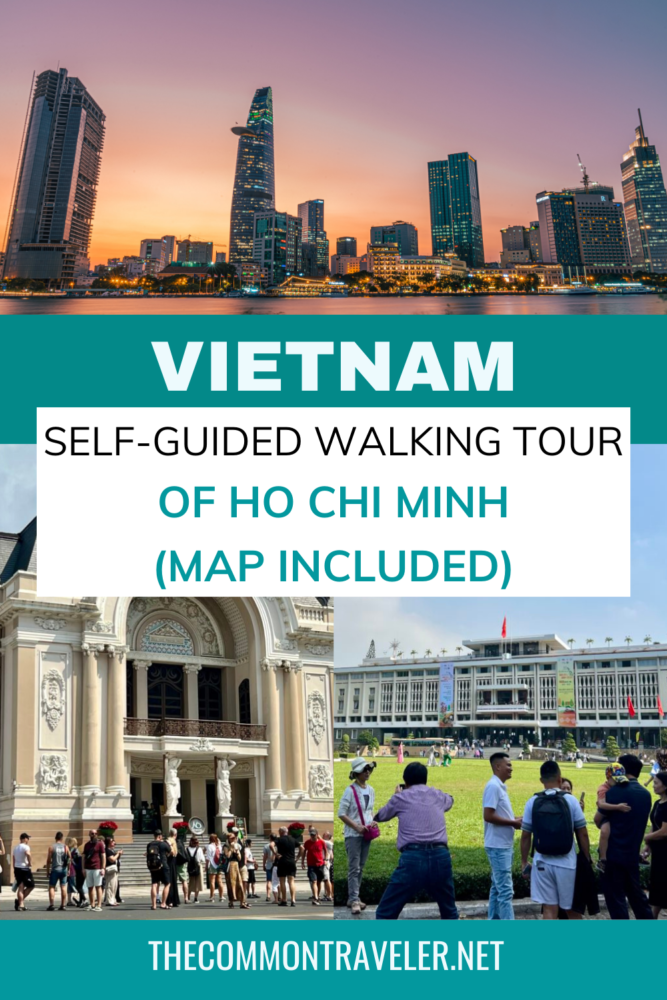
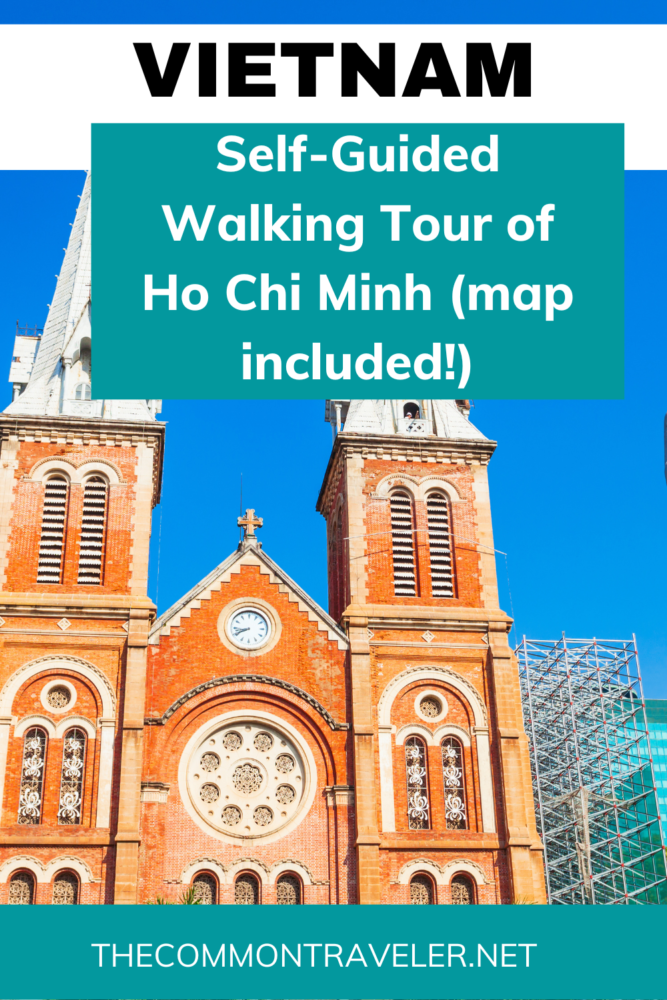






 Raised as a third culture kid living in South America and Europe, Annick caught the travel bug early. As an empty-nester, Annick enjoys sharing her tips for traveling for those with champagne taste and beer budgets.
Raised as a third culture kid living in South America and Europe, Annick caught the travel bug early. As an empty-nester, Annick enjoys sharing her tips for traveling for those with champagne taste and beer budgets.